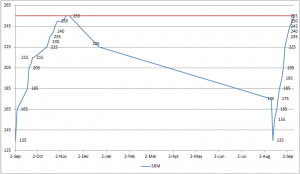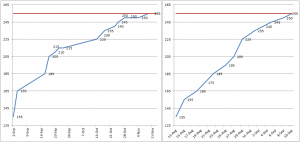I restarted my weightlifting program exactly 30-days ago and during that time I’ve performed 14-sessions. While I was inputting my squat data into my phone at the gym today I noticed something interesting/awesome. I had re-achieved the previous 5RM PR that was in my recording app from the last time that I was lifting weights. For those of you who don’t know a “5RM” is a “five repetition maximum” (generally shortened to “five rep max”) which is the heaviest weight that you can do for five consecutive repetitions.
(Note: Technically I suppose that a 5RM would be the most weight you could do for five repetitions in a single set, but for a variety of reasons that I won’t go into here I don’t do maximum rep testing – for the time being. Therefore in this particular instance the 5RM we are talking about is the weight that I use for my work sets, of which I do three across. Which is a long way of saying that today I squatted as much in my workout as I did the last time I squatted before the last time I quit. Um . . . let’s just move on.)
That is pretty awesome because I remember when I achieved this level of strength the first time I was quite pleased with my performance. Another reason this got my dopamine flowing is because I feel like I got back to this level quickly without hurting myself or rushing my progress by making too large increases. Did I really get back in form faster than I first achieved it? Or was my mind memory playing tricks on me. My curiosity was aroused so I went into my weight lifting app and pulled out the data that it had in it for my back squat. Coincidentally, the data went back to 24 September 2013, almost exactly a year ago! So of course I made a chart. Here it is:
I like this chart because it shows the last time I got to this level and this time, with the gap in between. Now I’m not excited that the gap is there, but it’s nice to quantify before, “not during” and after. Just seeing this chart and the start-overedness of it reinforces how much I want and need to maintain a workout program over the long term. And my performance potential if I did so.
Now let’s look at the two actual training periods and compare them:
The biggest takeaway for me from these two charts is consistency. I don’t depict it well here because the Excel formatting is just too hard but the chart on the left which shows the first period of weight training represents a number of missed workouts. You can also see during that period I repeated at the same weight several times. Also, the increases in weight are inconsistent. I jump by 30# and then 20# and then 5# and then 10# and so on. All told it took me 72-days to advance from 3 sets of 5 across at 135# to 3 sets of 5 across at 255#.
In the chart on the right – which shows the current progression – it only took me 27-days to get from 135# to 255#! There were no missed workouts and with one exception I was very patient, consistent and conservative in my weight increases. I definitely feel that this gave my body a better chance to recover, adapt and prepare for the next weight increase than the herky-jerky increases in the first instance. Finally though, I think that I was much better prepared mentally this time around. As with so many things in life it is the unknown that messes with our heads. The second time through anything is easier just from knowing what to expect and knowing what you can do.
The big question now is what does the chart look like from here through the next thirty days?

